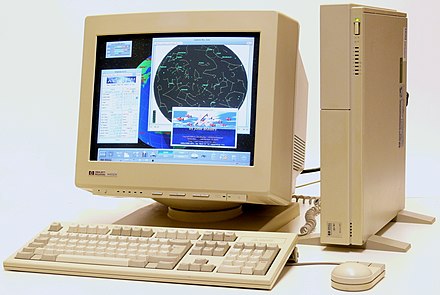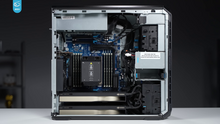
A workstation is a special computer designed for technical or scientific applications.[2] Intended primarily to be used by a single user,[2] they are commonly connected to a local area network and run multi-user operating systems. The term workstation has been used loosely to refer to everything from a mainframe computer terminal to a PC connected to a network, but the most common form refers to the class of hardware offered by several current and defunct companies such as Sun Microsystems,[3] Silicon Graphics, Apollo Computer,[4] DEC, HP, NeXT, and IBM which powered the 3D computer graphics revolution of the late 1990s.[5]
Workstations formerly offered higher performance than mainstream personal computers, especially in CPU, graphics, memory, and multitasking. Workstations are optimized for the visualization and manipulation of different types of complex data such as 3D mechanical design, engineering simulations like computational fluid dynamics, animation, video editing, image editing, medical imaging, image rendering, computational science, and mathematical plots. Typically, the form factor is that of a desktop computer, which consists of a high-resolution display, a keyboard, and a mouse at a minimum, but also offers multiple displays, graphics tablets, and 3D mice for manipulating objects and navigating scenes. Workstations were the first segment of the computer market[6] to present advanced accessories, and collaboration tools like videoconferencing.[5]
The increasing capabilities of mainstream PCs since the late 1990s have reduced distinction between the PCs and workstations.[7] Typical 1980s workstations have expensive proprietary hardware and operating systems to categorically distinguish from standardized PCs. From the 1990s and 2000s, IBM's RS/6000 and IntelliStation have RISC-based POWER CPUs running AIX, and its IBM PC Series and Aptiva corporate and consumer PCs have Intel x86 CPUs. However, by the early 2000s, this difference largely disappeared, since workstations use highly commoditized hardware dominated by large PC vendors, such as Dell, Hewlett-Packard, and Fujitsu, selling x86-64 systems running Windows or Linux.



The first computer that might qualify as a workstation is the IBM 1620, a small scientific computer designed to be used interactively by a single person sitting at the console.[8] It was introduced in 1959.[9] One peculiar feature of the machine is that it lacks any arithmetic circuitry.[10] To perform addition, it requires a memory-resident table of decimal addition rules.[11] This reduced the cost of logic circuitry, enabling IBM to make it inexpensive. The machine is codenamed CADET and was initially rented for $1000 per month.
In 1965, the IBM 1130 scientific computer became the successor to 1620. Both of these systems run Fortran and other languages.[12] They are built into roughly desk-sized cabinets, with console typewriters. They have optional add-on disk drives, printers, and both paper-tape and punched-card I/O.
Early workstations were generally dedicated minicomputers, a multiuser system reserved for one user. For example, the PDP-8 from Digital Equipment Corporation, is regarded as the first commercial minicomputer.[13]
The Lisp machines developed at MIT in the early 1970s pioneered some workstation principles, as high-performance, networked, single-user systems intended for heavily interactive use. Lisp Machines were commercialized beginning 1980 by companies like Symbolics, Lisp Machines, Texas Instruments (the TI Explorer), and Xerox (the Interlisp-D workstations). The first computer designed for a single user, with high-resolution graphics (and so a workstation in the modern sense), is the Alto developed at Xerox PARC in 1973.[14] Other early workstations include the Terak 8510/a (1977),[15] Three Rivers PERQ (1979), and the later Xerox Star (1981).
In the early 1980s, with the advent of 32-bit microprocessors such as the Motorola 68000, several new competitors appeared, including Apollo Computer and Sun Microsystems,[16] with workstations based on 68000 and Unix.[17][18] Meanwhile, DARPA's VLSI Project created several spinoff graphics products, such as the Silicon Graphics 3130. Target markets were differentiated, with Sun and Apollo considered to be network workstations and SGI as graphics workstations. RISC CPUs increased in the mid-1980s, typical of workstation vendors.[19]
Workstations often feature SCSI or Fibre Channel disk storage systems, high-end 3D accelerators, single or multiple 64-bit processors,[20] large amounts of RAM, and well-designed cooling. Additionally, the companies that make the products tend to have comprehensive repair/replacement plans. As the distinction between workstation and PC fades, however, workstation manufacturers have increasingly employed "off-the-shelf" PC components and graphics solutions rather than proprietary hardware or software. Some "low-cost" workstations are still expensive by PC standards but offer binary compatibility with higher-end workstations and servers made by the same vendor. This allows software development to take place on low-cost (relative to the server) desktop machines.
Workstations diversified to the lowest possible price point as opposed to performance, called the thin client or network computer. Dependent upon a network and server, this reduces the machine to having no hard drive, and only the CPU, keyboard, mouse, and screen. Some diskless nodes still run a traditional operating system and perform computations locally, with storage on a remote server.[21] These are intended to reduce the initial system purchase cost, and the total cost of ownership, by reducing the amount of administration required per user.[22]
This approach was first attempted as a replacement for PCs in office productivity applications, with the 3Station by 3Com. In the 1990s, X terminals filled a similar role for technical computing. Sun's thin clients include the Sun Ray product line.[23] However, traditional workstations and PCs continued to drop in price and complexity as remote management tools for IT staff became available, undercutting this market.






A high-end workstation of the early 1980s with the three Ms, or a "3M computer" (coined by Raj Reddy and his colleagues at CMU), has one megabyte of RAM, a megapixel display (roughly 1000×1000 pixels), and one "MegaFLOPS" compute performance (at least one million floating-point operations per second).[24] RFC 782 defines the workstation environment more generally as "hardware and software dedicated to serve a single user", and that it provisions additional shared resources. This is at least one order of magnitude beyond the capacity of the personal computer of the time. The original 1981 IBM Personal Computer has 16 KB memory, a text-only display, and floating-point performance around 1 kFLOPS (30 kFLOPS with the optional 8087 math coprocessor. Other features beyond the typical personal computer include networking, graphics acceleration, and high-speed internal and peripheral data buses.
Another goal was to bring the price below one "megapenny", that is, less than $10,000 (equivalent to $28,000 in 2023), which was achieved in the late 1980s. Throughout the early to mid-1990s, many workstations cost from $15,000 to $100,000 (equivalent to $200,000 in 2023) or more.
The more widespread adoption of these technologies into mainstream PCs was a direct factor in the decline of the workstation as a separate market segment:[25]

Since the late 1990s, the workstation and consumer markets have further merged. Many low-end workstation components are now the same as the consumer market, and the price differential narrowed. For example, most Macintosh Quadra computers were originally intended for scientific or design work, all with the Motorola 68040 CPU, backward compatible with 68000 Macintoshes. The consumer Macintosh IIcx and Macintosh IIci models can be upgraded to the Quadra 700. "In an era when many professionals preferred Silicon Graphics workstations, the Quadra 700 was an intriguing option at a fraction of the cost" as resource-intensive software such as Infini-D brought "studio-quality 3D rendering and animations to the home desktop". The Quadra 700 can run A/UX 3.0, making it a Unix workstation.[27] Another example is the Nvidia GeForce 256 consumer graphics card, which spawned the Quadro workstation card, which has the same GPU but different driver support and certifications for CAD applications and a much higher price.
Workstations have typically driven advancements in CPU technology. All computers benefit from multi-processor and multicore designs (essentially, multiple processors on a die). The multicore design was pioneered by IBM's POWER4; it and Intel Xeon have multiple CPUs, more on-die cache, and ECC memory.
Some workstations are designed or certified for use with only one specific application such as AutoCAD, Avid Xpress Studio HD, or 3D Studio Max. The certification process increases workstation prices.

Modern workstations are typically desktop computers with AMD or NVIDIA GPUs to do high-performance computing on software programs such as video editing, 3D modeling, computer-aided design, and rendering.[28]
By January 2009, all RISC-based workstation product lines had been discontinued:
In early 2018, RISC workstations were reintroduced in a series of IBM POWER9-based systems by Raptor Computing Systems.[33][34] The Mac transition to Apple silicon greatly increased power efficiency and size efficiency over x86-64 with its ARM-based RISC architecture.[35]